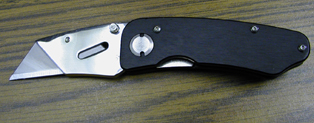its paid sponsors, whose products you need!
“Stay ‘unreasonable.’ If you
don’t like the solutions [available to you], come up with your
own.”
Dan Webre
The Martialist does not
constitute legal advice. It is for ENTERTAINMENT
PURPOSES ONLY.
Copyright © 2003-2004 Phil Elmore, all rights
reserved.
Selecting a Knife
By Phil Elmore
WARNING! Knife training
and the use of a knife for self-defense are inherently dangerous activities.
Take these suggestions at your own risk.
The Martialist
disclaims any liability resulting from injuries sustained while training using
these ideas.DO NOT CARRY ANYTHING THAT IS
ILLEGAL OR YOU WILL PAY FOR IT.
The Martialist is not responsible if you
choose to break the law.
Okay, you’ve decided that you understand the
responsibilities you accept when you choose to carry a knife for self-defense.
You’ve checked your local laws and you know what you can legally carry.
You have multiple options, and before you can decide how to carry your
legal knife, you must decide what to carry.
What’s it going to be?
Choosing a knife from among all the permissible sizes and
types is really a matter of personal style, of likes and dislikes. I
can offer some general advice, but the specifics are (yet again) up to the
individual. Here I offer what tips I can on the matter.
First, shall you carry a folder or a fixed blade?
Fixed-blades are stronger and generally preferable for self-defense, but they
are less likely to be legal. It is a lot easier, when confronted with law
enforcement scrutiny, to justify the presence of a folding utility knife and/or
tactical folder than to justify the presence of a fixed-blade knife. Most
tactical folders can be seen as utility pieces, but a fixed blade on any
suburbanite or city dweller will be seen as a weapon only.

It’s a good knife, but is it
legal to carry?
What blade shape do you prefer?
Do you like the strong angular lines of the
Americanized
Tanto, or is a clip-point blade more
your preference? Whatever knife you carry, it should be one you like.
What about exotic knives? A balisong or butterfly
knife has a lot of style and may appeal to you personally, but it’s a lot more
likely that a butterfly knife is banned where you live. The same goes for
other exotic or
unusual
blades. You may really like
stilettos, for
example, but find you should avoid the stigma often attached to them.

Butterfly knives are often
illegal.
Laws covering “gravity knives” may be an issue
in your locality, too. Sometimes a knife that simply opens using some form
of inertia can be construed as a gravity knife, even though an accurate
definition of “gravity knife” covers only knives specifically designed
to drop open when a button is pressed.

This tri-fold knife from
Cold
Steel
might be seen as a gravity knife.
Pay attention to the name of your knife, too. It
sounds silly, but a jury or a judge will look more critically at a knife with a
dangerous-sounding name than one that sounds more neutral or utilitarian.

The Blackie Collins
“Ninja,” whose name might evoke the
wrong associations in court after a self-defense incident.
Depending on how you conduct your
life, you might find that the knife you’ve chosen to carry is easy to tote some
days but more difficult on others, depending on your wardrobe and activities.
You might want to find a knife sold with a multiple-option carry system.
That way you can change how you carry the knife depending on your needs (though
be aware that this may cause trouble if you cannot instinctively deploy the
blade — it is better to carry a knife consistently).

This
Camillus
boot knife can be clipped inside a
waistband or boot, worn horizontally on a belt, or
worn IWB using a special loop built into the sheath.
If the knife you prefer is a simple locking
folder that has no means of one-hand opening, don’t worry. Almost any
knife can be opened with one hand using a forceful wrist-snap or the “New
York Open.” If you must have a thumb stud, though, you can buy
one and clamp it to your favorite locking folder.


The One-Arm Bandit can be clamped
to a lockback, turning it into a
tactical folder. As of this writing, the Bandit is available in two sizes.
If your need is primarily for utility rather
than self-defense, you might carry a razor knife of some kind. There are
countless variations on the standard removable-razor-blade utility knife out
there, including the Stanley Sport Utility Tools
and folding clip knives that hold disposable blades. Avoid these as
self-defense tools. Particularly after September 11, 2001, the
associations people hold where razor blade knives are concerned are far more
trouble than they are worth. Boxcutters are also specifically illegal in
some areas, owing to their popularity with juvenile offenders.

Folding razor knife. Avoid
carrying these for self-defense.
I keep coming back to this theme, but the
choice of a self-defense knife is really not one that anyone can make for you.
Learn everything you can and make your decision an informed one. You may
feel free to
e-mail
me questions about specific knives and knife-related issues, but remember
that I am not a lawyer.
I cannot be held responsible for anything you do.
